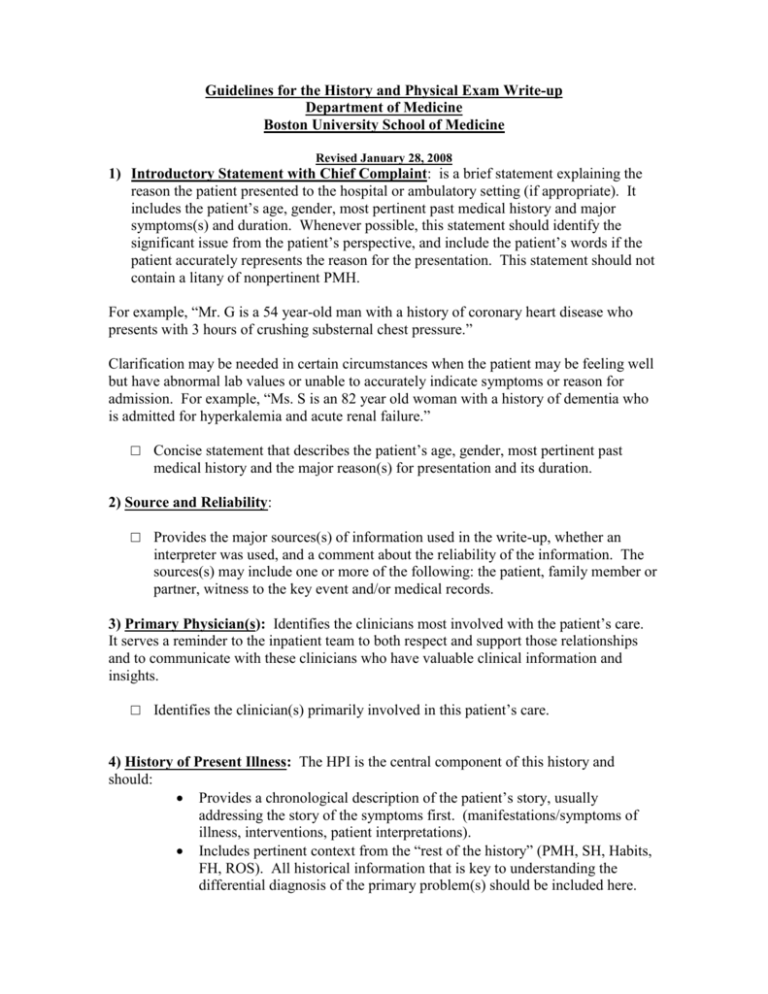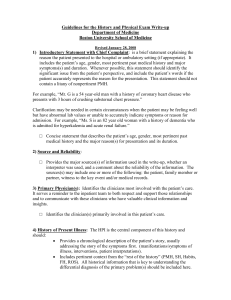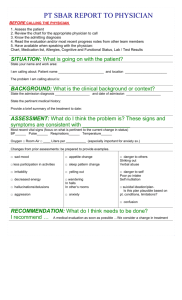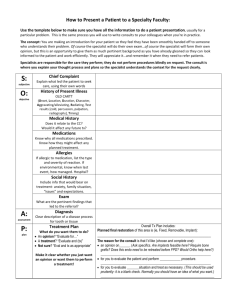Guidelines for the History and Physical Exam Write-up
advertisement

Guidelines for the History and Physical Exam Write-up Department of Medicine Boston University School of Medicine Revised January 28, 2008 1) Introductory Statement with Chief Complaint: is a brief statement explaining the reason the patient presented to the hospital or ambulatory setting (if appropriate). It includes the patient’s age, gender, most pertinent past medical history and major symptoms(s) and duration. Whenever possible, this statement should identify the significant issue from the patient’s perspective, and include the patient’s words if the patient accurately represents the reason for the presentation. This statement should not contain a litany of nonpertinent PMH. For example, “Mr. G is a 54 year-old man with a history of coronary heart disease who presents with 3 hours of crushing substernal chest pressure.” Clarification may be needed in certain circumstances when the patient may be feeling well but have abnormal lab values or unable to accurately indicate symptoms or reason for admission. For example, “Ms. S is an 82 year old woman with a history of dementia who is admitted for hyperkalemia and acute renal failure.” □ Concise statement that describes the patient’s age, gender, most pertinent past medical history and the major reason(s) for presentation and its duration. 2) Source and Reliability: □ Provides the major sources(s) of information used in the write-up, whether an interpreter was used, and a comment about the reliability of the information. The sources(s) may include one or more of the following: the patient, family member or partner, witness to the key event and/or medical records. 3) Primary Physician(s): Identifies the clinicians most involved with the patient’s care. It serves a reminder to the inpatient team to both respect and support those relationships and to communicate with these clinicians who have valuable clinical information and insights. □ Identifies the clinician(s) primarily involved in this patient’s care. 4) History of Present Illness: The HPI is the central component of this history and should: Provides a chronological description of the patient’s story, usually addressing the story of the symptoms first. (manifestations/symptoms of illness, interventions, patient interpretations). Includes pertinent context from the “rest of the history” (PMH, SH, Habits, FH, ROS). All historical information that is key to understanding the differential diagnosis of the primary problem(s) should be included here. The HPI should be written in prose with full sentences and be a narrative that builds an argument for the reason the patient was admitted. □ Has a starting point (i.e. “the patient was in her usual state of health until 5 days prior to admission.). □ Has appropriate flow, continuity, sequence, and chronologic order. □ Provides a chronological description of symptoms, interventions (by the patients, MD, others) and pertinent patient interpretations of the symptoms. This may include the ER/MICU course or prior therapeutic treatments e.g. chemotherapy. □ Contains an appropriate characterization of key symptoms—onset, quality, quantity, location, setting, chronology (including whether the symptom is constant of intermittent, progressive or improving),modifying factors, severity including impact on function and associated symptoms. □ Incorporates pertinent (needed to understand the differential diagnosis) elements of past medical history, family history, social history, substance use and review of symptoms. (i.e. for chest pain: CHD risk factors are included at the end of the HPI; DVT/PE risk factors included if pertinent; if COPD/asthma is being considered, indicate use of steroids, prior hospitalizations, prior intubations and recent PFTS included in HPI.). □ Includes pertinent positive and negatives which demonstrate the presenter’s thought process about the differential diagnosis. □ Places results of tests performed prior to the admission in the HPI only if they contribute data that impacts on the subsequent evaluation and treatment or dramatically change how you view the patient. The remainder of significant prior tests should be described in either the PMH in the section with the appropriate diagnosis or in the labs/studies section if they are being compared to the current test. 5) Past Medical History: □ List of diagnoses with specific details i.e. onset, complications, past workup and important test results. □ Prioritizes diagnoses according to severity and relation to case. □ Lists past hospitalizations/surgeries with dates or ages. 6) Medications: □ Dose, route, frequency for each medication. □ When appropriate include when medication was started or dosage changed and for what purpose. □ Includes over the counter medications and herbal medications. □ Group medications by class or indications and in relation to this admission. 7) Allergy/Adverse Reactions to Medications: □ Lists of allergies and the adverse reactions. 8) Family history: □ Describes the state of health of all first degree relatives. □ Documents all significant positive and negative family history that is pertinent to the patient’s major problem(s) for first and second degree relatives. 9) Social history/Habits: □ Describes occupation, significant social relationships and support systems. (e.g. marital status, sexual partners, housing, other social supports) □ Describes functional status( such as ADLs, and IADLs or other functional assessment as indicated), living conditions). □ Describes alcohol, smoking, and recreational drug use including details about attempts to quit or reason for relapses. □ CAGE questionnaire vs. AUDIT-C if patient is ready to quit use if applicable to the patient. □ Where pertinent, provides detailed occupational, sexual, travel histories and places this information in the HPI. 10) Review of Systems: □ All systems are described: constitutional, skin, HEENT, cardiovascular, respiratory, gastrointestinal, genital/urinary, neurologic, psychiatric, musculoskeletal, heme/lymph with 3 or more questions for each system □ Thorough evaluation of several systems pertinent to the HPI should be included in the HPI. □ No incorporation of PMHX i.e. should not have heart murmur here 11) Physical exam: □ Vital signs- thorough vital signs including Temp, HR, BP, RR, O2, height, weight,, orthostatic BP/ HR when appropriate, □ General description- comfort/distress of patient, patient appearance and specific features □ Thorough physical exam that includes each system: General, Skin, HEENT, Neck including thyroid, CVS- include JVP/HJR, pulses, carotids, bruits, PMI etc, Respiratory- including observation and percussion, abdominal including liver and spleen, rectal, genitourinary (if indicated), musculoskeletal/extremity, neurologic, psychiatric, lymph nodes. □ More detailed focused exam related to chief complaint. 12) Labs/Studies: □ Documents all tests ordered at or just prior to admission □ Groups the test logically (e.g. for a patients admitted with chest pain, results of the CK, troponin, EKG and CXR are listed first and grouped together.) □ Abnormal results of tests are compared to prior tests when available. (E.g. TTE with decreased EF from 50% to 20% in 7/06, or old hematocrit of 42 compared to new hematocrit of 24) If the student is comparing a current test to a prior then both should be in this section. However old tests that don’t need to be compared should be placed in the PMH section. 13) Synthesis: □ Provides a 2-3 line synthesis that integrates the central information from the history, exam and studies and points toward a leading diagnosis, if possible, or diagnostic imperative (diagnosis that must be excluded because of its probability, potential morbidity and treatability) □ Student should commit to a leading diagnosis if possible. 14) Problem List/Assessment/Plan/Discussion: The A/P should demonstrate the student’s thinking and should usually run approximately 1-2 typed pages. □ Provides a complete problem list that should include all active or pertinent medical problems including those discovered on ROS, physical exam, or labs/studies. □ Problems should be listed in order of importance. □ Problems should be identified at the highest level of specificity possible and not as a “system” (e.g. the problems should be “chest pain” or “acute coronary syndrome” and not “cardiac”). □ Each problem should have its own assessment and plan. Lower priority problems should have a considerably shorter assessment and plan. □ The assessment should include: o Patient specific differential diagnosis and discussion that is NOT a summary or list from textbook or UPTODATE. o A commitment to a leading diagnosis. o A weighted list of 3-5 active alternative diagnoses with emphasis on the diagnostic imperative. (a diagnosis that because of its probability/morbidity/treatability must not be missed). o Support for the diagnostic possibilities that attempts to explicitly link the diagnostic possibilities to the patient’s clinical findings and integrates pathophysiology where appropriate; compare and contrast the diagnostic possibilities. o If the patient is admitted with an established diagnosis (e.g. decompensated CHF) then the assessment needs to indicate the plausible etiologies for the worsening diagnosis. (E.g. arrhythmia, ischemia, med nonadherence, diet indiscretion, etc.). □ The plan should include recommendations: o To evaluate the problems. o To treat the problems. o To provide patient education. □ The plan should include consideration of the benefits and risks to this patient, the patient’s values and preferences and the social predicament. □ The assessment and plan should incorporate pertinent references, textbooks, literature as they apply to the primary problem. Do not exceed 2-4 references. 15) Overall Evaluation/Considerations: □ Be legible. □ No plagiarism from outside sources or other health care providers. (cite literature when you use it). □ Use proper grammar and spelling. □ Avoid abbreviations if possible and make sure your audience understands the abbreviations. It is your responsibility to make the write-up understandable to the reader. □ The write up should be of appropriate length. The assessment and plan should be 1-2 typed pages. In general the remainder of the write up should be 3-5 pages. □ The write up should be organized according the format outlined above. This document was developed by the Department of Medicine Working Group on Student Write-Ups at Boston University School of Medicine—Christine Phillips and Craig Noronha, Co-Chairpersons; Joel Caslowitz, Daniel Chen, Mellissa DiPetrillo, Jeffrey Greenwald, James Meisel, Nila Radhakrishnan, Suzy Sarfaty, David Thornton, Warren Hershman.






